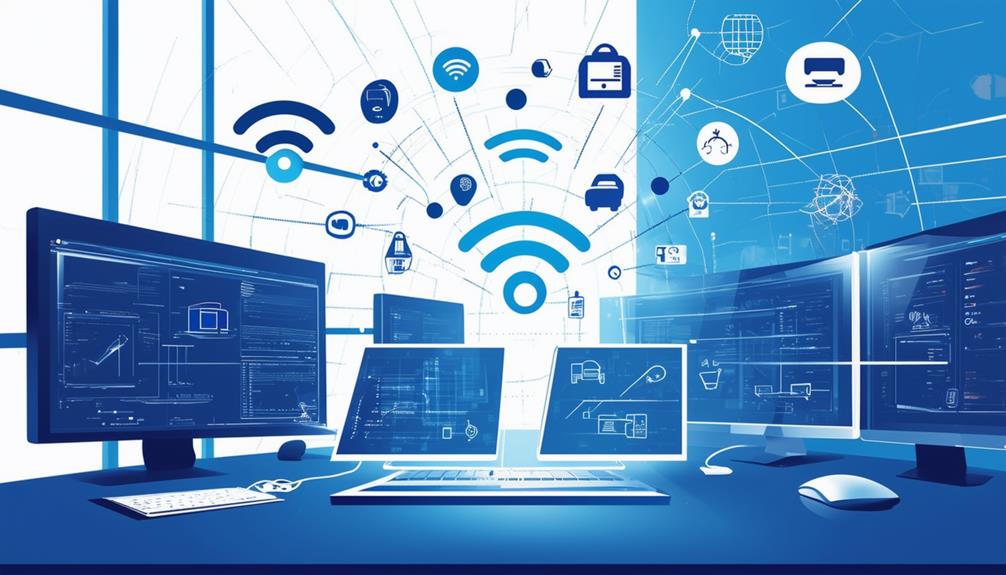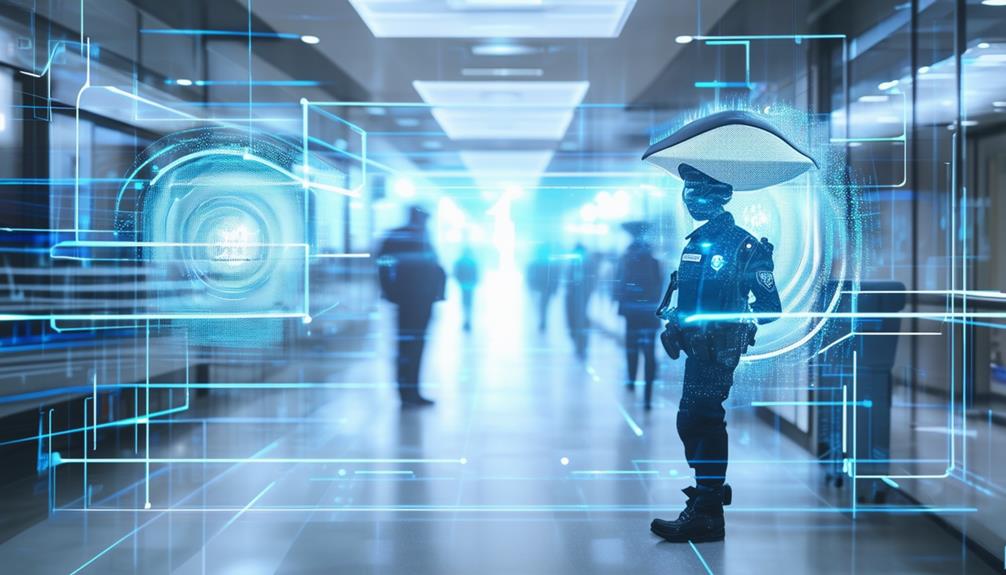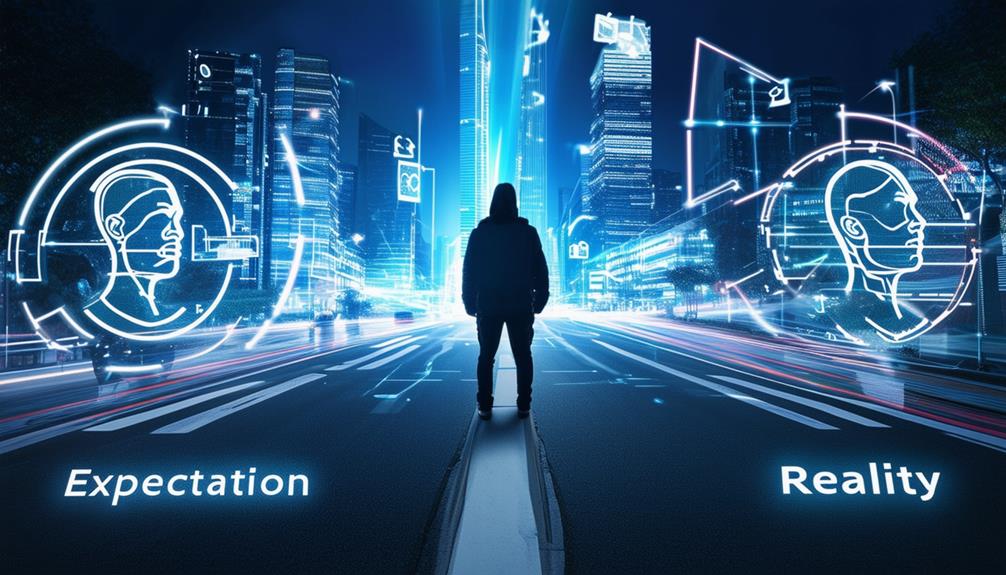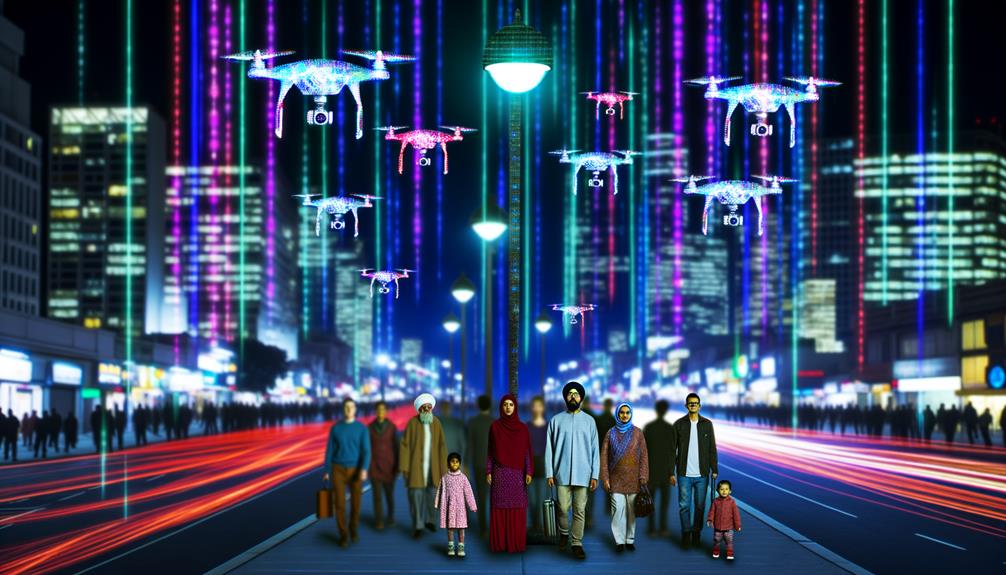New advancements in biometric surveillance have transformed the landscape of identification and tracking. Remote sensing technology can detect heartbeat signatures from a distance, while WiFi network monitoring creates detailed user profiles indoors. Microbial cell surveillance offers fine-grained insights into human activities. Odor recognition technology is also emerging. Such powerful tools raise important privacy concerns, but their potential in law enforcement cannot be ignored. As surveillance capabilities continue to expand, the balance between public safety and individual privacy becomes increasingly vital. There's much more to explore in this rapidly evolving arena.
Key Takeaways
- Biometric surveillance advances include gait recognition, remote heartbeat detection, and microbiome detection for precise identification.
- Odor recognition technology holds promise, leveraging unique body odor signatures for individual re-identification.
- WiFi network monitoring can track precise user movements and behaviors indoors without cameras.
- Cardiac signatures and laser doppler vibrometry enable non-invasive, remote heartbeat detection for surveillance.
- Integration of advanced AI and machine learning enhances biometric surveillance performance and decision-making in various settings.
Surveillance of Biometric Properties
The scope of biometric surveillance is expanding across numerous modalities, including advanced behavioral and physiological properties. Today, the focus has shifted from traditional methods like facial recognition technology to more refined approaches. This evolution is exemplified by the integration of gait recognition technology, which can identify individuals based on their walking style. Police forces in China have already tested this technology, highlighting its effectiveness even when the subject's face is obscured.
One of the most promising advancements is heartbeat detection using remote sensing technologies. The Pentagon's Jetson system employs laser doppler vibrometry to detect surface movement caused by a person's heartbeat, allowing for identification even through clothing. This unique cardiac signature offers a more reliable form of biometric identification compared to facial recognition, which can be deceived or disguised.
Moreover, microbiome detection technology has shown potential for re-identifying individuals with notable accuracy. As these technologies continue to evolve, our society is witnessing a major leap in biometric surveillance capabilities.
Heartbeat Detection From Distance
Using laser doppler vibrometry, I can detect heartbeats remotely via surface movement caused by cardiac activity, thereby enhancing biometric surveillance capabilities. This advanced surveillance technology leverages remote sensing technologies to accurately identify individuals from a distance, transforming the landscape of identification and tracking.
The Pentagon's Jetson system, for instance, boasts 95% accuracy under favorable conditions. This technology outperforms facial recognition, which can be compromised by factors such as beards or sunglasses. Additionally, cardiac signatures are robust biomarkers, and their remote collection offers a non-intrusive method of surveillance, providing authorities with a notable advantage in monitoring suspects.
In the domain of surveillance, heartbeat detection from a distance opens new horizons. Remote sensing technologies now allow for the detection of heartbeats accurately and reliably, transcending traditional methods.
As this technology integrates with existing biometric databases, it will greatly enhance the capabilities of law enforcement agencies. The implications are profound, promising to transform the world of biometric surveillance.
WiFi Network Monitoring

I can leverage WiFi network monitoring to create detailed profiles of individual users based on their unique interactions with WiFi signals, adding another dimension to indoor surveillance. This technology allows me to pinpoint user activities with high accuracy.
By tracking the strength and patterns of WiFi signals, I can reconstruct the precise movements and behaviors of individuals within indoor spaces. This is especially valuable for monitoring user activities in real-time, providing insights into their daily routines and preferences.
WiFi network monitoring can detect even the slightest movements, such as a person walking across the room or sitting down on a couch. Its high accuracy is due to the ability to differentiate between signals emitted and received by different WiFi-enabled devices.
By analyzing these signals, I can create detailed maps of user interactions, revealing patterns and habits that might otherwise go unnoticed. This technology offers a non-intrusive way to gather data on user behaviors and preferences.
It can monitor indoor movements without the need for cameras, making it a more privacy-preserving method of surveillance. Moreover, WiFi network monitoring can be integrated into various applications, such as smart home systems, shopping malls, and office buildings to enhance safety and optimize operations.
Microbial Cell Surveillance
Microbial cell monitoring takes surveillance technology to the microscopic level, reconstructing activities and movements by tracking the unique microbial signatures left behind by individuals. This cutting-edge method offers a new dimension in identification and tracking capabilities.
Unlike traditional biometric surveillance, microbial cell monitoring harnesses the distinct microbial communities on our skin and other surfaces to identify and monitor individuals. Studies have shown that up to 80% of people can be re-identified even a year later, making this technology a powerful tool for enhancing security measures and tracing individuals across various environments.
The potential applications of microbial cell monitoring are vast, with its ability to provide fine-grained insights into human activities and movements. By leveraging advancements in DNA sequencing and data analysis, this novel approach enables forensic investigators to pinpoint the presence of specific individuals at crime scenes.
Additionally, microbial cell monitoring offers a unique opportunity to transform the way we conduct surveillance, moving beyond traditional methods and into the field of precision tracking. As this technology continues to evolve, we can expect significant advancements in the field of surveillance and identification.
Odor Recognition in Development

Now, I'm interested in examining the advancements in odor detection, specifically looking at methods for verifiable identity verification through chemical signature matching.
This technology has been proposed as a contactless physical biometric, which could potentially be employed for surveillance purposes.
Odor Detection Advancements
Even as technology continues to advance, one largely untapped frontier of recognition surveillance is odor biometrics. Investigations into the microbial signatures within the human nasal microbiome indicate that specific bacterial taxa, such as Actinobacteria, Bacteroidia, Bacilli, Clostridia, and Proteobacteria, are associated with decreased olfactory function, suggesting potential applications in odor recognition technologies.
These findings could lead to significant advancements in odor detection and expansion of its capabilities in surveillance. For example, researchers are developing techniques to identify individuals based on their unique body odor signatures. This knowledge can be critical in forensics and tracking.
| Area | Advancement | Potential Impact |
|---|---|---|
| Digestive Tract | Microbial signatures influencing behavior | Enhancing odor-based tracking |
| Nose | Specific bacteria and olfactory function | Improved odor recognition |
| Skin | Microbes shaping body odor | Unique individual identification |
| Forensics | Scent lineups and analysis | Increased reliability of evidence |
| Technology | Microbiome detection development | Increased use in surveillance |
As research continues to unravel the intricacies of smell, the future looks promising for the growth of odor biometrics and its potential integration into various surveillance systems.
Identity Verification Methods
As researchers investigate further into the domain of odor recognition technology, they're exploring ways to harness the distinctiveness and individuality of human scents for identity verification purposes. This field is progressing rapidly, with numerous studies demonstrating high accuracy in identifying individuals based on their unique odor patterns.
Advancements in sensor technology have enabled the development of more sophisticated and versatile methods of capturing and analyzing these patterns. One notable application is in public spaces, where odor recognition can potentially enhance safety and security without infringing on civil liberties. The non-intrusive nature of this technology makes it an appealing alternative to traditional biometric systems like face recognition systems, which often raise privacy concerns.
Chemical Signature Matching
I explore the relatively uncharted territory of chemical signature matching, where researchers are aiming to capture the distinct and nuanced constituents of human scents. This emerging area within odor recognition technology holds substantial potential for mass surveillance applications, particularly in the domain of scent-based identification. One notable study involving chemical analysis of human sweat, for example, showcases the progress made in this field.
| Example Study | Method | Accuracy |
|---|---|---|
| Japanese Research | Breath Analysis | 97% |
| US Study | Sweat Analysis | High (Details Not Provided) |
| Other Research | Microbiome Analysis | Promising but Incomplete |
These studies highlight the various approaches to chemical signature matching and the essence of human uniqueness. Further advancements in this technology could lead to reliable methods for monitoring and tracking individuals. Despite the challenges reported by researchers, such as the impact of diet and disease on chemical signatures, the advancements in this field raise promising prospects for surveillance methodologies that rely on chemical signatures and scent recognition.
Machines Identifying Bum Shapes
As I explore the world of recognition surveillance tech, I'm intrigued by the avant-garde method that uses rear view analysis for biometric shape profiling.
By leveraging sensor technology to measure drivers' rear end shapes, this innovative approach offers a unique solution to combat car theft.
This sophisticated system highlights the diversity and potential of surveillance methods beyond traditional biometrics.
Rear View Analysis
Japanese researchers have developed an innovative anti-theft system that harnesses advanced sensor technology to identify drivers based on the unique shapes and structures of their buttocks. This highly sophisticated system leverages the distinct characteristics of each individual's rear end to enhance anti-theft measures. By measuring and analyzing the specific anatomical features of drivers, the technology can accurately distinguish one driver from another, thereby providing an unparalleled level of identity verification.
In this cutting-edge technology, recognition technology is key to identification purposes. The sensors focus on the precise shape and structure of the driver's rear end, which acts as a distinct biometric marker. By doing so, the system builds a thorough profile of the driver's unique features, allowing it to differentiate between individuals. This level of precision guarantees that the anti-theft measures are both tailored and robust, providing drivers with enhanced security and the freedom to protect their vehicles effectively.
Biometric Shape Profiling
Sensor-equipped car seats leveraging advanced biometric shape profiling can accurately differentiate drivers based on distinctive rear end shapes, thereby strengthening anti-theft security. This innovative technology utilizes 360 sensors to capture the unique characteristics of each individual's lower body, effectively creating a biometric fingerprint of their rear end. The system boasts a remarkable accuracy rate of 98%, significantly enhancing vehicle security.
| Advantages | Considerations |
|---|---|
| Precise Identification | Potential Inconvenience |
| Improved Security | Privacy Concerns |
This groundbreaking approach to recognition technology has the potential to revolutionize anti-theft measures in the automotive industry. By identifying drivers based on their unique biometric shape profiles, car manufacturers can guarantee that vehicles are secure from unauthorized use. As this technology continues to evolve, it is essential to weigh the benefits against potential drawbacks and consider the ethical implications involved in such biometric profiling.
Law Enforcement and Privacy

Facial recognition technology saw a ripple of dissatisfaction among local governments, including San Francisco, which banned its use by law enforcement and all other municipal agencies to prevent potential misuse and address growing privacy concerns. The backlash was driven by evidence revealing significant disparities in the technology's accuracy based on race and gender. Cities like Boston and several other Massachusetts cities joined San Francisco in their bans, reflecting the trend of distrust towards major tech companies providing facial recognition technology to law enforcement.
Major tech companies like Amazon, Microsoft, and IBM have similarly withdrawn from offering facial recognition technology amidst intense scrutiny. The momentum towards regulation accelerated in the aftermath of George Floyd's murder in May 2020, leading to increased discussions of a statewide ban in Massachusetts. A bipartisan state bill aims to limit police access to this technology, which could set a national precedent.
As the public becomes increasingly aware of the intrusive nature of facial recognition and its potential biases, law enforcement agencies must reconsider their use of this technology to maintain public trust and uphold individual rights.
Future of Remote Surveillance
The expanding boundaries of facial recognition technology are now augmenting their intrusive reach via advancing remote surveillance methods that incorporate biometric features like gait recognition and heartbeat detection. These cutting-edge tools enable authorities to track individuals remotely with uncanny precision, monitoring every aspect of their being.
The growing sophistication in surveillance technology raises vital questions about individual privacy, as government agencies and private corporations increasingly exploit facial recognition and other biometric markers to enhance public safety.
The deployment of Wi-Fi routers for motion tracking and even indoor movement monitoring further pushes the envelope of surveillance capabilities. Additionally, new odor recognition systems have emerged, using scent-based identification techniques to supplement traditional methods.
While these innovations boost surveillance efficiency, concerns about privacy and the unchecked expansion of such technologies loom large. With the constant evolution of surveillance tech, it becomes imperative for society to weigh the balance between securing public safety and safeguarding individual privacy.
Public Expectations Vs. Reality

How accurately do our daily encounters with facial recognition technology align with the vital concerns they evoke? This question has become increasingly relevant as the technology expands its reach, amplifying anxieties about privacy invasion and selective biases.
While we may appreciate the enhanced security and efficiency facial recognition can provide, we can't afford to disregard the darker side it brings forth.
In reality, facial recognition is often plagued by biases based on race and gender. Scientific studies have shown that these systems are less accurate for darker-skinned individuals, exacerbating the very biases that exist in society. Meanwhile, surveillance technologies are being used without transparency or consent, making citizens feel like they're under constant observation. Cities like San Francisco and Massachusetts have acknowledged these concerns by introducing regulations and bans.
It's vital that we continue to examine the balance between security needs and individual privacy rights, ensuring our pursuit of technological progress doesn't sacrifice our fundamental freedoms. By confronting these challenges, we can shape a future where technology serves us, rather than the other way around.
Protecting Identity in Surveillance
As the digital net widens, penetrating questions arise: Are we unwittingly sacrificing our identities to the silent observers that patrol our urban landscapes? The integration of facial recognition technology into surveillance systems raises concerns about our privacy in an increasingly connected world.
BriefCam's v5.3, for instance, enhances speed and precision in identification through multi-camera search capabilities, making it a potent tool for law enforcement. This advanced technology, powered by Deep Neural Networks, can automatically recognize individuals in security footage and compare them to a database of known faces.
However, it's essential to strike a balance between leveraging this technology for public safety and safeguarding personal privacy. As the use of facial recognition expands, it's important to develop robust policies governing its use to prevent abuse.
Efficient use cases, such as identifying people in large crowds, can greatly aid investigations, but we must guarantee these capabilities don't come at the cost of our freedom to be anonymous. The line between protecting society and respecting individual privacy must be constantly monitored to avoid an overreach.
Frequently Asked Questions
What Cities Have Banned Facial Recognition Technology?
Cities like San Francisco and Austin have prohibited facial recognition technology, driven by privacy concerns and ethical implications of government overreach.
Is Facial Recognition Technology Good or Bad?
"As I weigh facial recognition technology's pros and cons, I believe it's not inherently good or bad; it raises privacy concerns and ethical implications, making potential misuse a significant threat to individual freedoms."
What States Do Not Allow Facial Recognition?
"I'm concerned about facial recognition. States disallowing it for privacy, legal, and ethical reasons include San Francisco and Massachusetts cities. As momentum grows, I see a shift towards restricting access and protecting individual freedom."
What Technology Is Used in Face Recognition?
"Fueled by facial recognition algorithms, biometric scanning harnesses surveillance applications to pinpoint individuals efficiently, leveraging machine learning to match faces with astounding accuracy, safeguarding our right to privacy."









